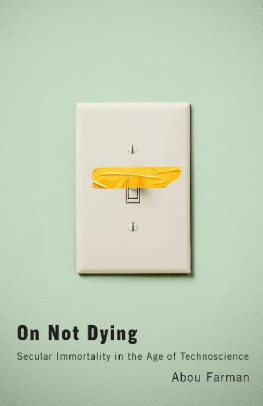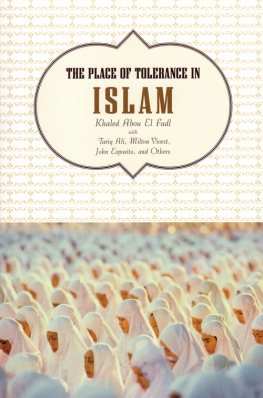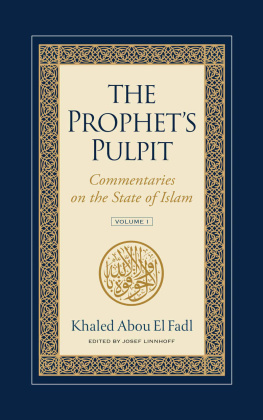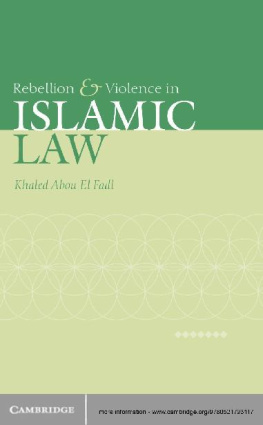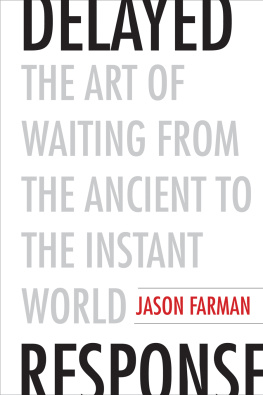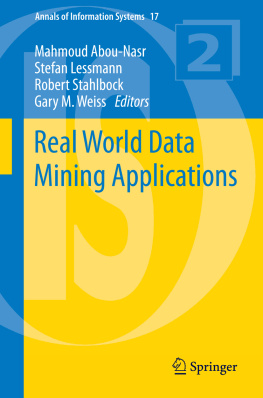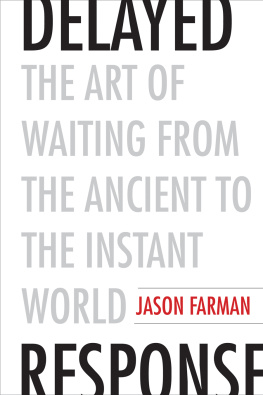Abou Farman - On Not Dying
Here you can read online Abou Farman - On Not Dying full text of the book (entire story) in english for free. Download pdf and epub, get meaning, cover and reviews about this ebook. year: 2020, publisher: University of Minnesota Press, genre: Religion. Description of the work, (preface) as well as reviews are available. Best literature library LitArk.com created for fans of good reading and offers a wide selection of genres:
Romance novel
Science fiction
Adventure
Detective
Science
History
Home and family
Prose
Art
Politics
Computer
Non-fiction
Religion
Business
Children
Humor
Choose a favorite category and find really read worthwhile books. Enjoy immersion in the world of imagination, feel the emotions of the characters or learn something new for yourself, make an fascinating discovery.
- Book:On Not Dying
- Author:
- Publisher:University of Minnesota Press
- Genre:
- Year:2020
- Rating:5 / 5
- Favourites:Add to favourites
- Your mark:
- 100
- 1
- 2
- 3
- 4
- 5
On Not Dying: summary, description and annotation
We offer to read an annotation, description, summary or preface (depends on what the author of the book "On Not Dying" wrote himself). If you haven't found the necessary information about the book — write in the comments, we will try to find it.
On Not Dying — read online for free the complete book (whole text) full work
Below is the text of the book, divided by pages. System saving the place of the last page read, allows you to conveniently read the book "On Not Dying" online for free, without having to search again every time where you left off. Put a bookmark, and you can go to the page where you finished reading at any time.
Font size:
Interval:
Bookmark:
Abou Farman

University of Minnesota Press
Minneapolis
London
Parts of chapter 3 were originally published as Death and the Infinite: Cryonics as Secular Eschatology, in The Wiley Companion to the Anthropology of Death, ed. ACGM Robben (New York: Wiley, 2018). Portions of chapter 4 were originally published as Speculative Matter: Secular Bodies, Minds, and Persons, Cultural Anthropology 28, no. 4 (2013): 73759. Parts of chapter 5 were originally published as Re-Enchantment Cosmologies: Mastery and Obsolescence in an Intelligent Universe, Anthropological Quarterly, special issue on Extreme: Humans at Home in the Cosmos, ed. D. Battaglia, D. Valentine, and V. Olson, 85, no. 4 (2012): 106988, and as Mind out of Place: Transhuman Spirituality, Journal of the American Academy of Religion 87, no. 1 (March 2019): 5780.
Copyright 2020 by Abou Farman
All rights reserved. No part of this publication may be reproduced, stored in a retrieval system, or transmitted, in any form or by any means, electronic, mechanical, photocopying, recording, or otherwise, without the prior written permission of the publisher.
Published by the University of Minnesota Press
111 Third Avenue South, Suite 290
Minneapolis, MN 55401-2520
http://www.upress.umn.edu
The University of Minnesota is an equal-opportunity educator and employer.
Library of Congress Cataloging-in-Publication Data
Names: Farman, Abou, author.
Title: On not dying : secular immortality in the age of technoscience / Abou Farman.
Description: Minneapolis : University of Minnesota Press, [2020] | Includes bibliographical references and index.
Identifiers: LCCN 2019027139 (ebook) | ISBN 978-1-4529-6190-3 (ebook)
Subjects: LCSH: Secularism. | Immortality. | Ethnology. | Religion and science.
Classification: LCC BL2747.8 (ebook) | DDC 306.9dc23
LC record available at https://lccn.loc.gov/2019027139
To the fullness of her afterlife
I knew I wanted to work on death and secularism. I had read the older ethnographies on deathranging from Bloch on Madagascar to Goody on the Lodagaa and Battaglia on the Sabarland was just exploring some of the new work on brain death, organ transplant, physician-assisted suicide, and persistent vegetative states in the United States when, down in the basement computer lab of the library of the City University of New Yorks Graduate Center, I stumbled upon a footnote about something called cryonics.
Sometimes a footnote can change your life. And maybe your death.
From the little I gleaned as I first followed the trail, it appeared to me that some people with a strongly scientific and avowedly atheist orientation were arguing that death was a medico-legal fiction. They were saying that humans could be preserved in a nondead state and revived later in the future. They were saying this could happen even after they had legally died.
Quickly, the footnote led me down a rabbit hole.
Although it all felt counterintuitive and somewhat disorienting, this first part sounded at least a little familiar from the work on brain death and organ transplant that had become staples of the anthropological literature. It also echoed discussions in the work on personhood and new reproductive technologies. In both, the line separating person and nonperson, life and death, consciousness and its lack, was at stake. Who could decide where the line was? On what criteria? With what consequences? That work, originally done in medical anthropology, was increasingly being taken up in the growing zone of encounter with science and technology studies and the anthropology of science and technology. Detailed and critical ethnographies by mostly feminist scholars such as Margaret Lock, Sharon Kaufman, Lynn Morgan, Rayna Rapp, and Susan Franklin inspired me, but, having started to think and work with the anthropologist Talal Asad, I kept sensing a lack of engagement with issues raised by Asad and others following his now well-known challenge to the social sciences: What might an anthropology of the secular look like?
At times religion was an object of analysis, in part because many of the challenges to orthodox medical and scientific regimes in the United States were coming from religious groups invoking religious values at the two ends of life: for example, in cases around abortion, stem-cell research, or brain death. Religion was where the conflict was seen to be (also see Feldman 2005). Modernity, too, was an object of critique in many key works, as it was said to have a particular orientation to disease and death and biology, a desire and need to master and measure and control, as well as a catastrophically Cartesian view of the mind and the body that surely had negative effects, especially in medicine. However, the secular and secularism appeared as background assumptions or side comments, if at all. Even though the scholarly work and the bioethical debates were replete with references to secular humanist values, I could find little analysis about what secular assumptions or rules were shaping these humanist debates and practices.
Cryonics seemed to be challenging the predominant medical, legal, and scientific views of death. Yet cryonicists were themselves reductive materialists, working with the same assumptions as most medical professionals and researchers. They were suggesting that if reductive materialism is truethat is, if your mind or self or individual identity is reducible to your brain statesthen logically you ought to be able to preserve that brain state if you had the proper technology to do so. One way to preserve that brain state, they further reasoned, was to cryopreserve it, just as other biological mattereven if only simple forms of itwas being frozen and then reused.
There is much more to what cryonicists were saying and doing, but what I had figured out up to then was that in a couple of buildings across the United States a few mostly white, mostly Western, mostly male, mostly atheist folks were suspended in liquid nitrogen, not dead but not alive, waiting to be reanimated in a distant future. They had been legally declared dead, with death certificates issued by the states medical examiner, but they were not considered dead by their custodians, the cryonicists who were storing and taking care of their frozen bodies in Detroit and Phoenix.
This smelled like anthropological territory for sure. Aside from a small book by a sociologist who had looked at their organizational structures and disputes in the 1970s (Sheskin 1979), nothing with academic heft had been written about this phenomenon. But before I committed to the topic I felt I needed to at least meet a cryonicist and get a sense of the ethnographic viability of the project, beyond articles and websites. Maybe I was making too much of all this. Maybe there was nothing to see, no there there. Online I came across someone from California, Christine Peterson, who was about to give a talk at a business conference at Princeton. Her name led me to the website of the Foresight Institute, an organization having to do with something called nanotechnology. She had set up the institute with her husband (at the time), Eric Drexler. At the time, all this felt beside the point to me really. I didnt realize how nanotechnology had any role to play in the game of death in the secular; neither did I realize that Drexler was recognized as the father of nanotechnology. All that mattered was that Peterson was a cryonicist. I emailed her to see if she would agree to meet up with me.
Font size:
Interval:
Bookmark:
Similar books «On Not Dying»
Look at similar books to On Not Dying. We have selected literature similar in name and meaning in the hope of providing readers with more options to find new, interesting, not yet read works.
Discussion, reviews of the book On Not Dying and just readers' own opinions. Leave your comments, write what you think about the work, its meaning or the main characters. Specify what exactly you liked and what you didn't like, and why you think so.

